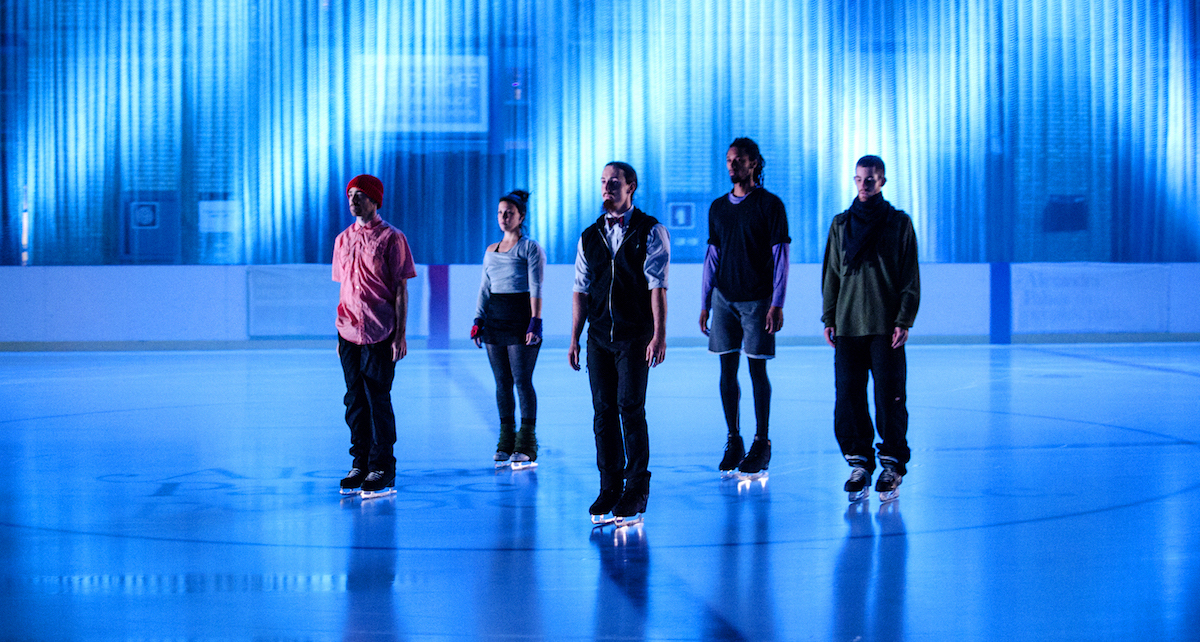From heavily sequined competition kitsch to serious high art, festival fodder? On ice? Really?
It sounds a little unlikely, but the Montreal-based collective Le Patin Libre has sprung from the tightly controlled world of the Canadian ice dance scene to bring something unique to the lexicon of contemporary dance theatre; and it’s not just sub-zero temperatures but the aesthetic possibilities of what they call “Glide”.
“We don’t think we’re doing dance on ice,” says the ensemble’s founder, Alexandre Hamel. “That would be a pastiche. That would be figure skating, which already is really good at transposing waltz, tango, can-can and all those on ice skates.”
Thus, when Le Patin Libre (or, literally, the free skate) lands at Docklands Arena this October to present the Australian exclusive season of its spectacular double bill Vertical Influences for the upcoming Melbourne Festival, the company will do as dancers, not skaters.

Le Patin Libre in ‘Vertical Influences’. Photo by Alicia Clarke for Dance Umbrella.
If you’re sensing a little creative friction between the domains of ice and contemporary dance, Hamel’s personal story underlines the point. “The initial inspiration was our passion for skating,” he begins. “Glide feels amazingly good. This is why people take risks to surf, and drive hours to ski resorts. This is why I was doing figure skating. However, the world and establishment of figure skating is, according to me, a toxic environment. Commercialism, pageantry, hyper-sexualisation of both boys and girls, an obsession with a very narrow view of perfection and performance, et cetera. In Canada, it was very intense and because it was always on TV, suburban mums became obsessed with it, especially when their sons started to do it.”
Le Patin Libre formed when Hamel teamed up with a bunch of frustrated ice dancers in 2005. Their goal was not only to escape the conservative, score card confines of ice dance schmaltz but to utilise Glide for “higher” purposes.
Hamel recalls how, at age 20, he had his dance epiphany. “I suddenly realised I never again wanted to smile and obey coaches in a sparkly outfit, to 1970s Hollywood soundtrack music,” he elaborates. “But I missed the physical action of skating. So, in the end, it was about re-appropriating those skills that were shoved into me by an organised establishment. Art and expression came later.”
Not only that, but serious critical applause. Eleven years down the track and Le Patin Libre is an internationally recognised groundbreaker, and the squealing “skate moms” have been replaced by dance/arts audiences and much vaunted festival commissions. As Hamel relates it, “After a few years of naive shows, we started to wonder, why skating? This brought us to look for what is unique in skating, and make it worthwhile to stay with the rink instead of switching to theatre or circus or whatever. We discovered this Glide and … artistic modernity! Our shows became a more sophisticated exploration of the uniqueness of Glide. At that point, the contemporary dance people kind of found us, and now here we are in big posh art festivals.”
Indeed, Vertical Influences has the classic trademarks of big festival performance. There is an element of spectacle (the athletic vigour and inherent danger of ice skating) and also of surprise (the audience sits on the ice during the second act). In addition, there is plenty of aesthetic passion.
“What we do and call contemporary skating is not about pleasing an audience,” Hamel stresses. “This just happens as a by-product, and we’re thrilled it does. It’s all about discovery through movement. Sometimes you discover yourself or ideas, or weird abstract concepts that words or other activities could not lead you to. And then, it’s about beauty, poetry and expression.”
As the terms “free skate” and “Glide” might suggest, the company’s signature is a kind of effortless effort. “Glide is the possibility to move through space without moving the body,” Hamel explains. “Or the possibility to free human locomotion from the organic movements associated with it: walking, running, jumping, crawling. It’s the base of what we now do. That’s the most important thing in our art. So, [even though] we are doing choreography, I like to think it is not dance. Dance would indeed be challenged, more than helped, by ice.”
For Melbourne Festival audiences, Le Patin Libre will perform its inter-related double bill of Influences and Vertical. The former explores issues around being an individual in a group, from peer pressure and exclusion to the discovery of connection and harmony. The latter picks up this motif and turns its focus onto the audience, smashing the fourth wall in the process. “It’s all about speed and the vertigo and un-naturalness that Glide creates in both audience and performers,” Hamel teases.
It’s a million miles from the likes of Torvill and Dean and Katarina Witt, skates notwithstanding. From its vantage point as a global arts darling, Le Patin Libre can now afford to smile at the travails that once beset the troupe. As Hamel remembers, “The very conservative Canadian people involved in ice sports described us as ‘a bad influence on kids’, and we were expelled from many rinks. We had to work outdoors, often at temperatures below minus 15 degrees. So we were thankful that the Canadian winter gave us free ice time.”
Free ice that soon turned into a state of free skate.
Le Patin Libre’s Vertical Influences will be presented at the Melbourne Festival October 15-22. For tickets and more information, click here.
By Paul Ransom of Dance Informa.
Photo (top): Le Patin Libre in ‘Vertical Influences’. Photo by Zoé Anne.

















